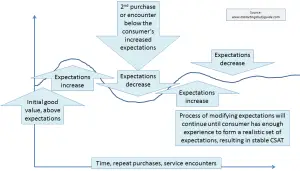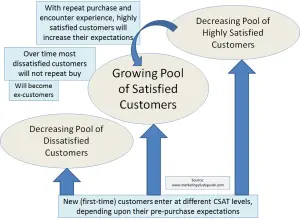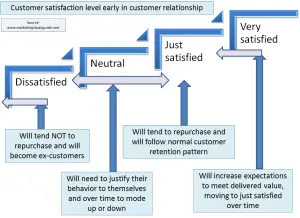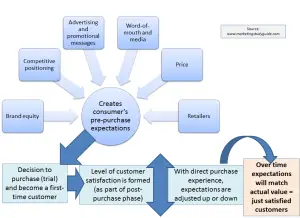Overtime most customers will be “just” satisfied
Many organizations find it frustrating that their customer satisfaction (CSat) scores reach a plateau and it becomes very difficult to achieve real increases in CSat. However, this is caused “naturally” and, overtime, all firms will find that their customer base primarily fits into the “just satisfied” range on their CSat scores.
This article and its various models is designed to explain why this phenomenon occurs. Let’s start by quickly reviewing what is customer satisfaction? (Please note that there are lots of articles on this site that discuss various aspects of customer satisfaction.)
Most firms will find – that overtime – their customer base will gravitate to “just satisfied”, because of the way that CSat is constructed.
Quick Recap of Customer Satisfaction
Customer satisfaction is formed from the interplay of the customer’s expectations of value compared against the value that they perceive that they actually receive.
Initially, as all customers start off as non-customers of the product or service, they need to and base their expectations of value on external cues such as:
- brand equity,
- word-of-mouth and media reports,
- price,
- packaging,
- competitive positioning,
- supporting retailers, and so on.
Because of the consumer’s use of non-purchase and consumption factors, their initial expectations may be quite appropriate or they may be well under or over stated – and these possible states will significantly impact their customer satisfaction outcomes.
Creating a high level of initial expectations is important to attract new customers. If a consumer (a potential customer) sees good value in a product or service, relative to competitive offerings, then they are more likely to buy the product and become a first-time customer.
However, at this point (as they are now a customer) they are able to evaluate and assess their customer satisfaction by a comparison between the value that actually received compared against their initial expectations. (Please note that the disconfirmation model of customer satisfaction is discussed in another article on this website.)
This is because they now have direct experience with the product or service – and it is this experience that will becomes more important in forming their expectations in the future.

(Click to enlarge)
From this point onwards, each new purchase or service encounter will continue to modify their expectations – either upwards, downwards or simply reinforce them. Over time their expectations will evolve to be in line with the value they are consistently receiving.
This process of modifying expectations is highlighted in the this diagram, showing a line graph of how customer satisfaction moves up/down before it stabilizes after repeated periods of purchase and consumption.
Why are most customers just satisfied?
If a service firm, for example, was to do a satisfaction survey of its customer base, it would therefore typically find that most of its customers are just satisfied. This occurs because the customers who are initially highly satisfied, will increase their expectations over time, and eventually they will become just satisfied – as highlighted in this diagram of how expectations, and therefore customer satisfaction, is modified over time.
Whereas consumers who are dissatisfied will tend to stop being customers. This means that a large firm with a customer database is likely to end up with most of its customers in the just satisfied category – as shown below in the following two diagrams.

(Click to enlarge)

(Click to enlarge)
Related Topics
Difference between Service Quality and Customer Satisfaction

